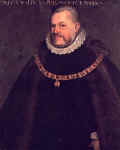Erich II.
|
 |
After the death of his father, duke Erich I. (1470-1540), Erich II. was raised by his Protestant mother, Elisabeth (1510-1558) of Brandenburg. She directed the regency in the principality of Calenberg - Göttingen with the aid of the estates of the realm until the eighteenth birthday of Erich II. During this time, Duchess Elisabeth inaugurated the Reformation in the entire land. Senior minister Anton Corvinus (1501-1553) helped the duchess with this. Subsequently, from 1542-1543, church inspections, conducted under the direction of Corvinus, were to determine whether religious services were conducted in the manner of the Reformation. The existing monasteries, however, were not to be done away with. Their property was maintained and the monasteries were for the most part remodeled as homes for women. Even today these monasteries and their lands provide the basis and the monastery rooms for the bishopric of Hanover in Lower Saxony.
When Erich II. took up the rule in the principality of Calenberg - Göttingen, he obeyed a summons from emperor Karl V. (1500-1558) to the Imperial Diet at Regensburg. Before his departure, however, the young duke had to swear loyalty to the Evangelical faith for the estates of Calenberg. Under the influence of the emperor and a few princes loyal to him, however, he was immediately pulled to their party and consequently to the Catholic faith. Duke Erich II. fought for the emperor after the victory of the Catholics in the Schmalkaldic War.1 The defeat at Drakenburg saved the north German territories from subjection to Emperor Karl V. In 1549 the reformer Corvinus was arrested by order of duke Erich II. and imprisoned in the fortress of Calenberg until shortly before his death. Erich II. was little concerned with the interests of his principality. He fought successfully as a troop leader in Italy, Spain, and France. For that he received, in 1573, the Order of the Golden Fleece from the hand of Philip II. (1527-1598) of Spain. But financial difficulties forced him to sell a part of the principality. In 1553 Heinrich the Younger (1489-1568), from the Wolfenbüttel line, fought successfully in the battle of Sievershausen against the wasteful politics of Duke Erich II. In a final inheritance agreement the two cousins came to terms concerning the future administration of the principality.
When Duke Erich II. died in Italy (Pavia) in 1584, he left behind no male descendents. Even today the completely preserved Renaissance castles of Hannoversch - Münden and Landestrost in Neustadt am Rübenberg bring to mind his government in the principality of Calenberg - Göttingen. After his death, the principality reverted to Duke Julius (1528-1589) from the Wolfenbüttel line.
--Adapted from the website, Die Welfen
![]()
Notes
1The Schmalkaldic War (1546-1547) was a brief and indecisive phase in the struggle between the Roman Catholic emperor Karl V. (1500-1558) and the Protestant party within the Holy Roman Empire. Because of other commitments, the emperor was unable to face the defensive alliance of Protestant states within the empire, known as the Schmalkaldic League, until 1546. But he was able to crush the League with the help of duke (later elector) Maurice of Saxony (1521-1553), winning a significant victory at the battle of Mühlberg (24 April 1547).
Sources
- Judge, Harry, ed. Oxford Illustrated Encyclopedia, 3 vols. New York: Oxford University Press, 1988.
- Kunze, Wolfgang. In the catalogue for the exhibition "Leben und Bauten Herzog Erichs II." Neustadt am Rübenberg, 1993.





